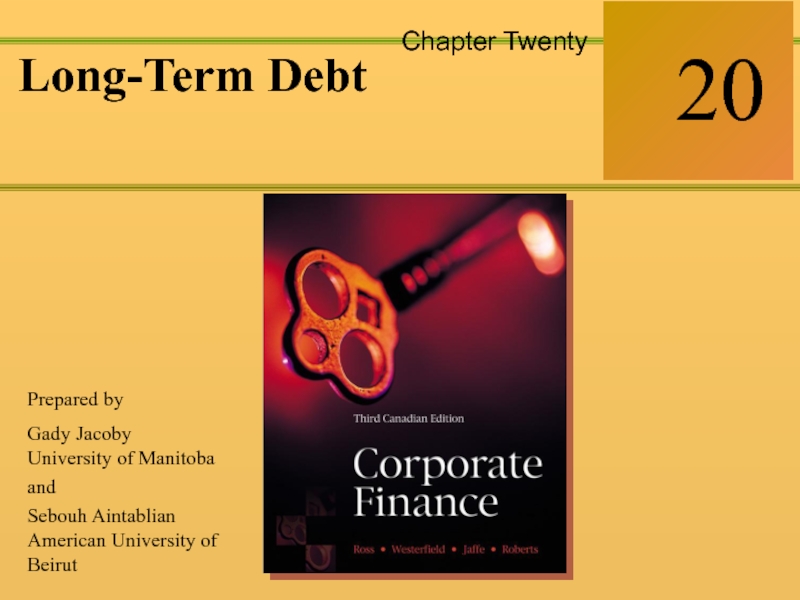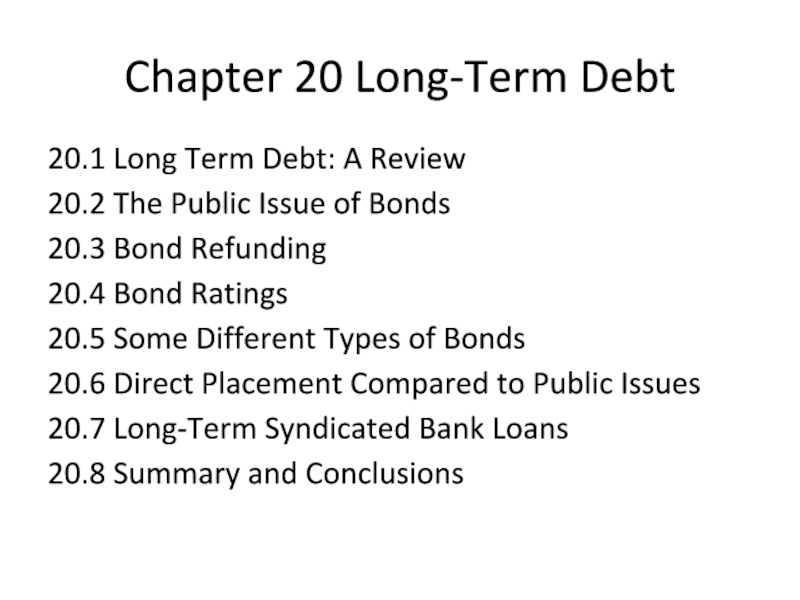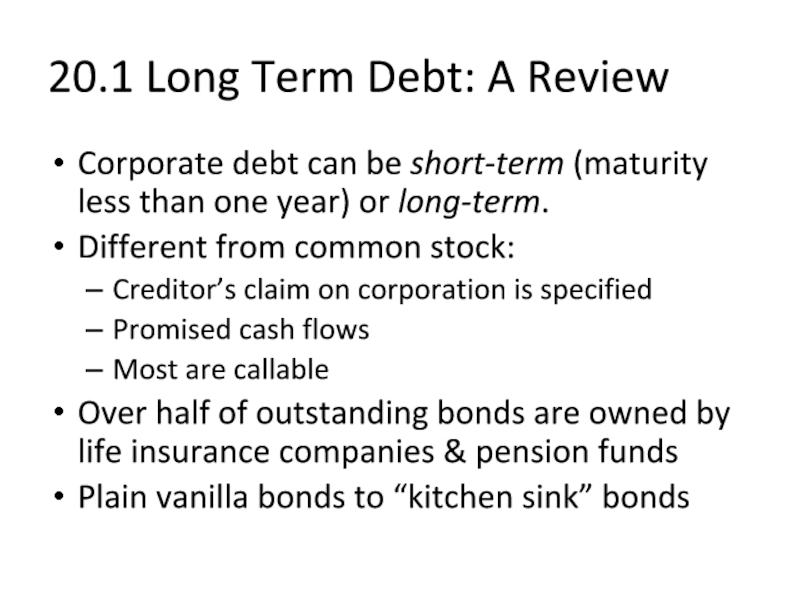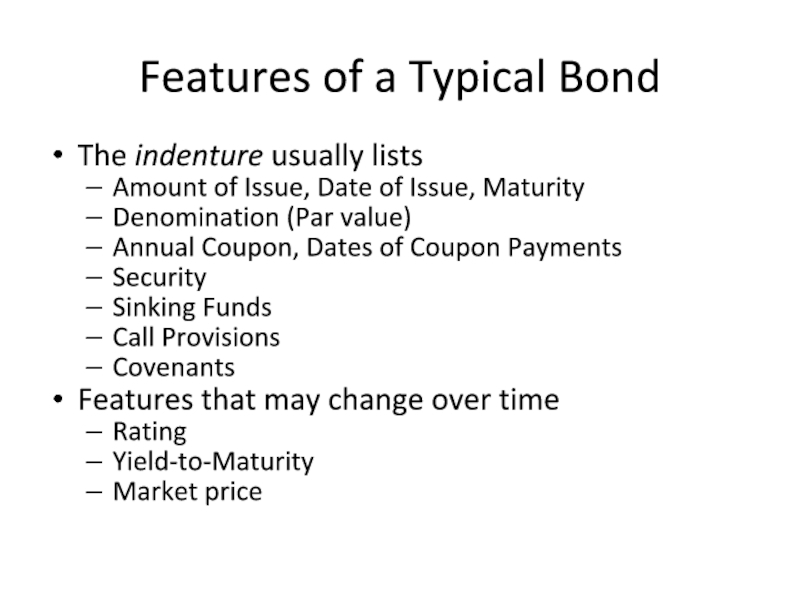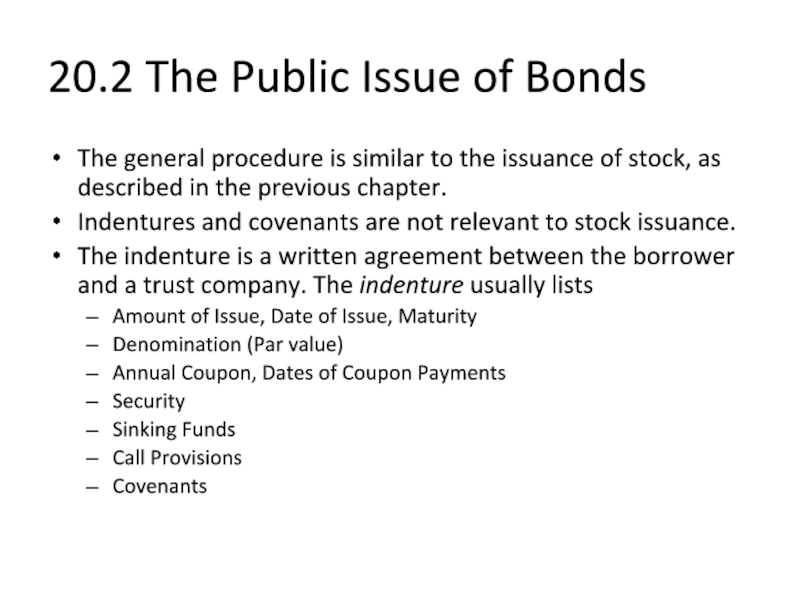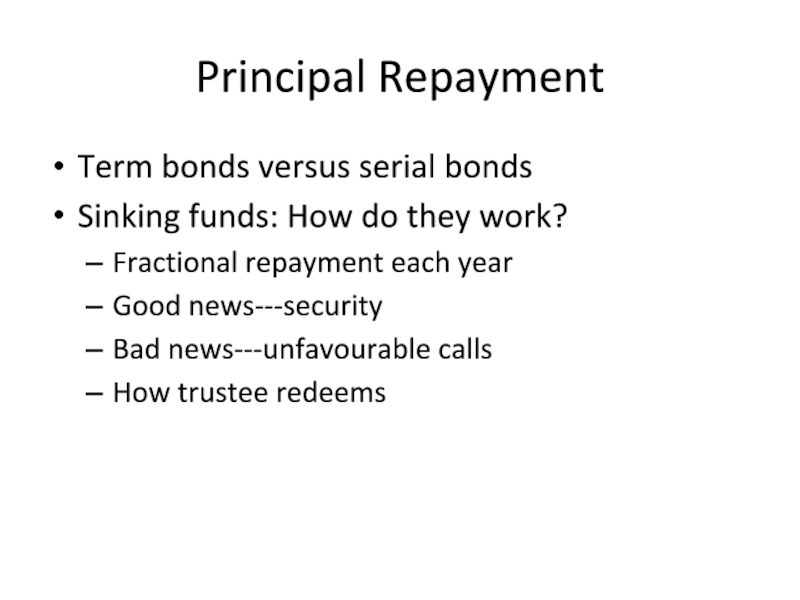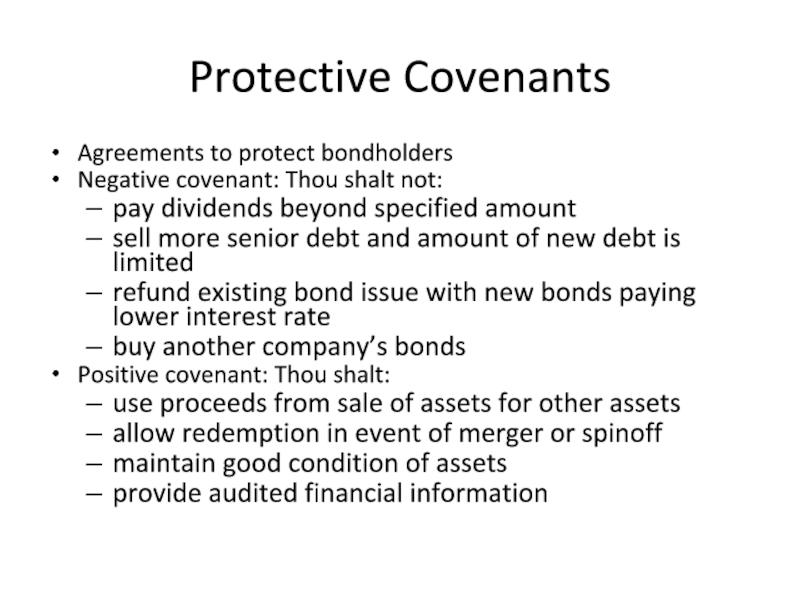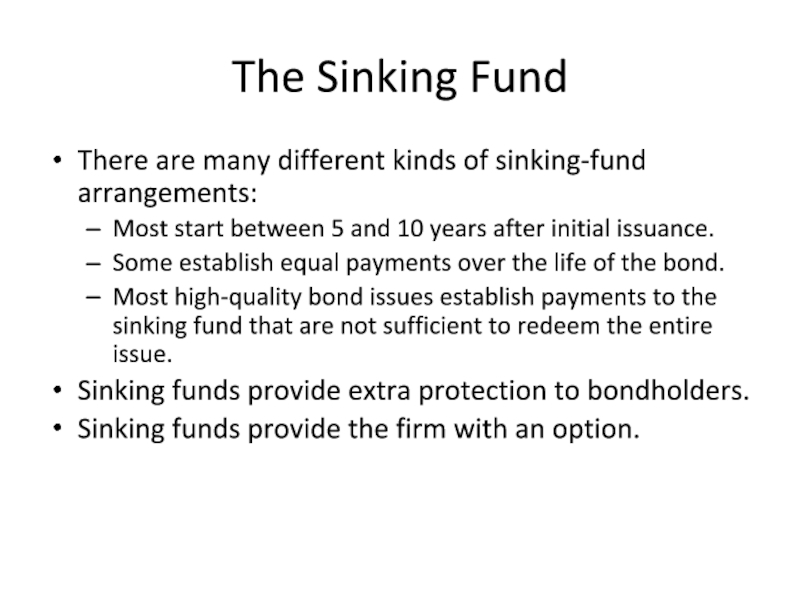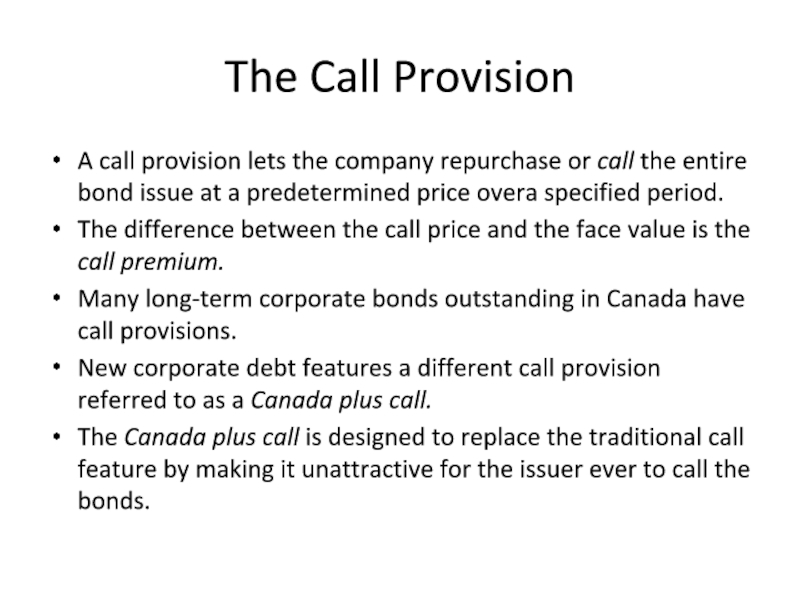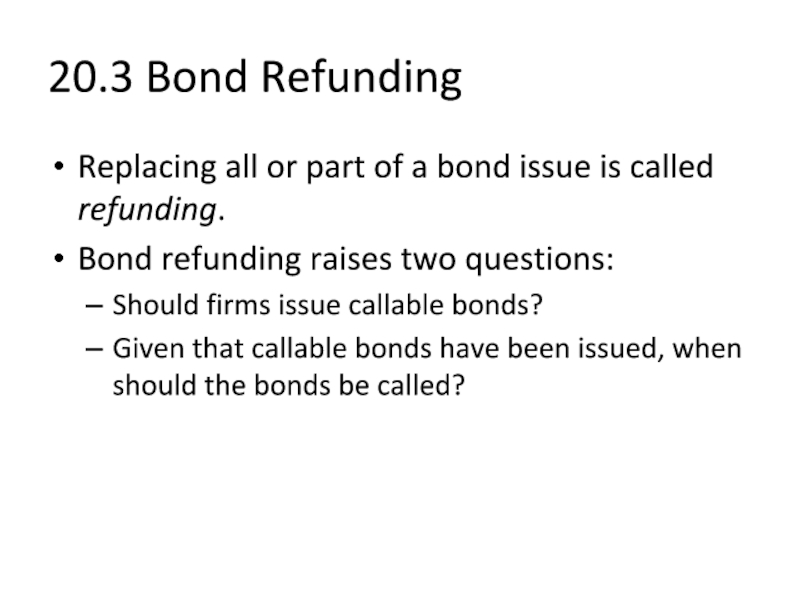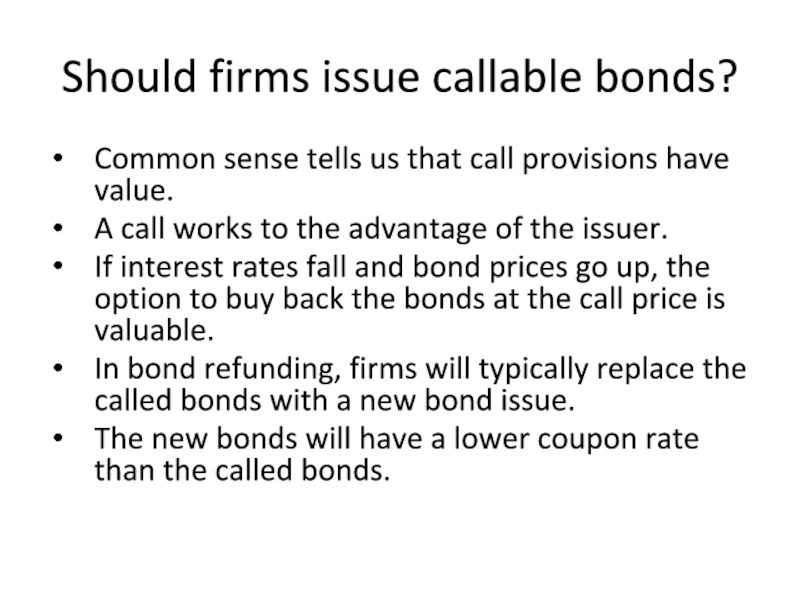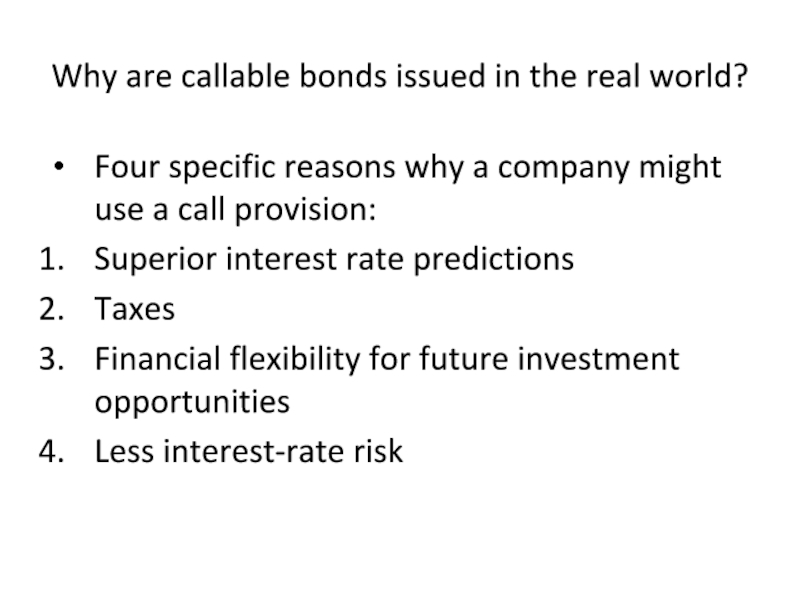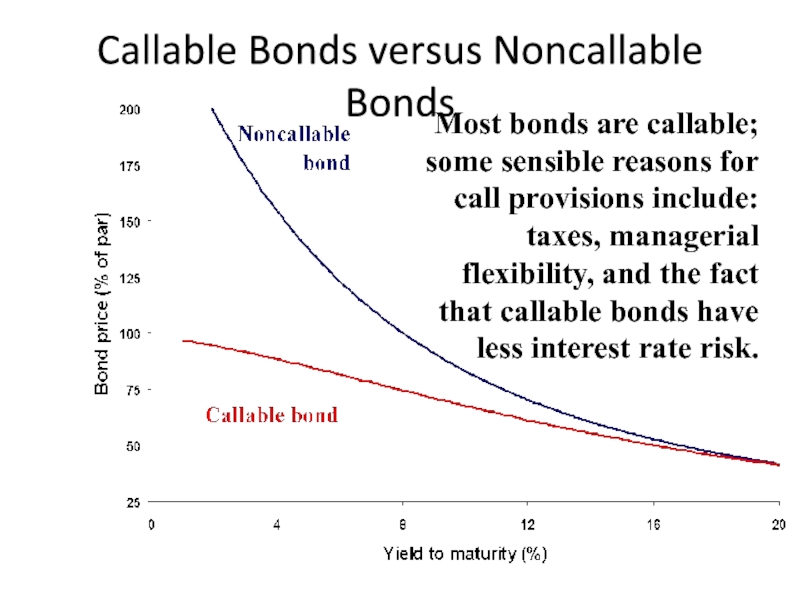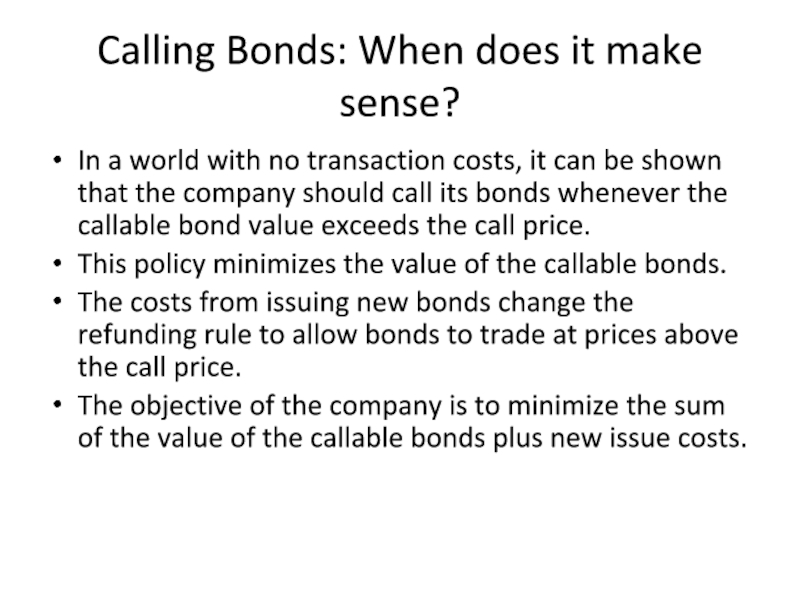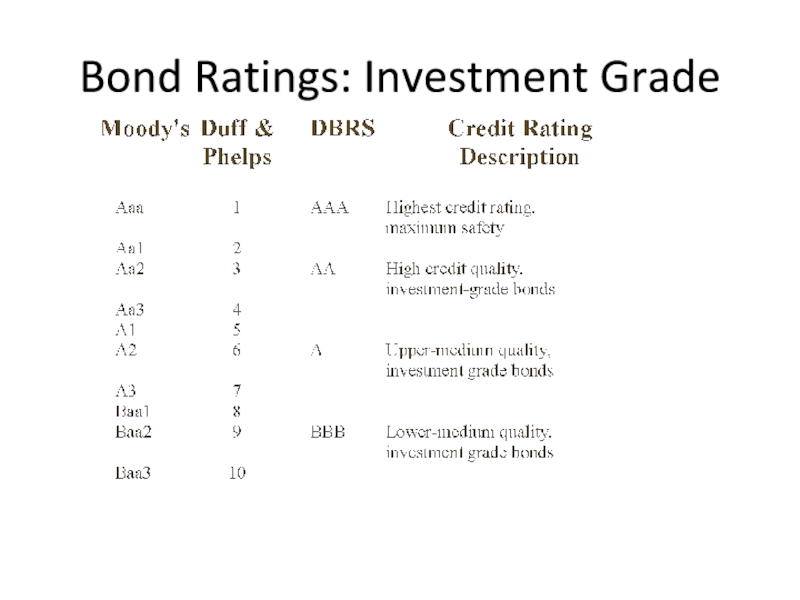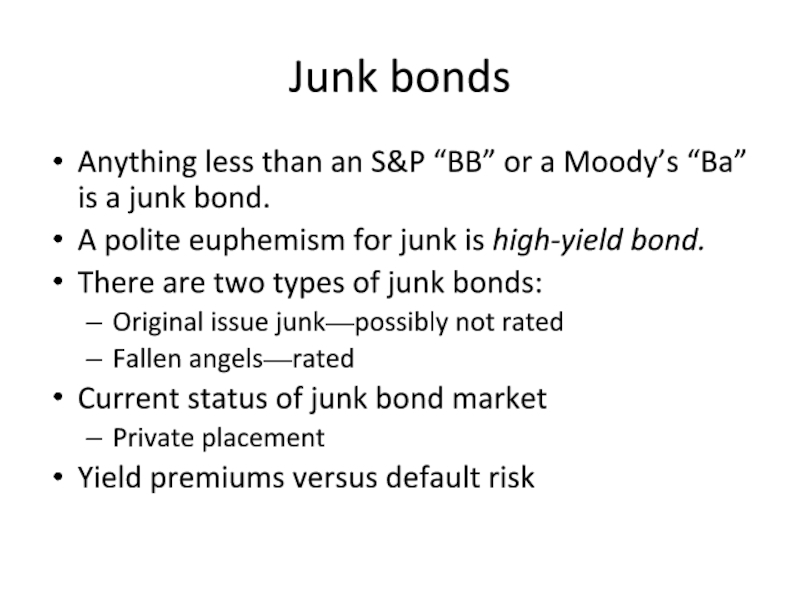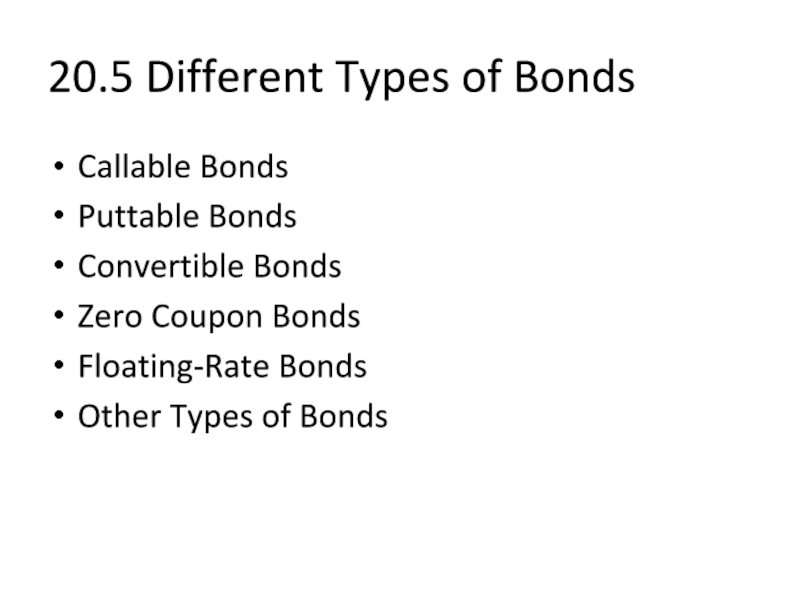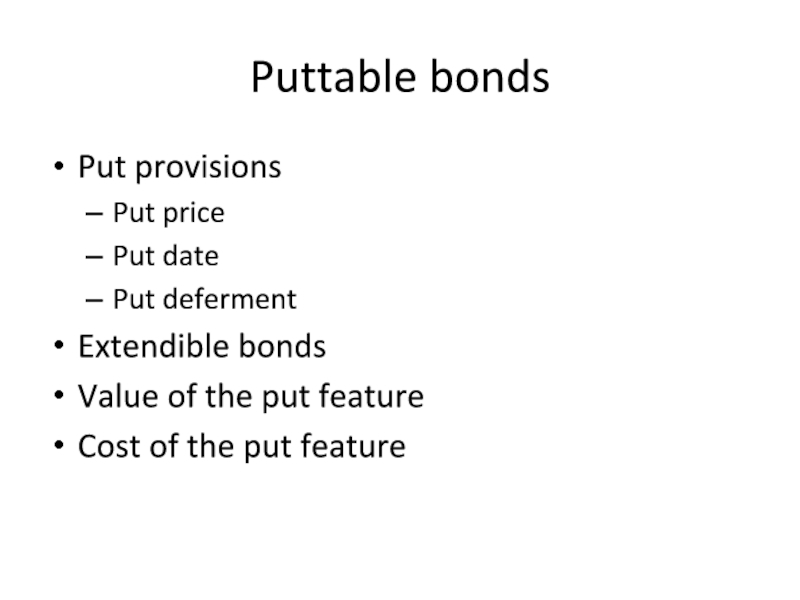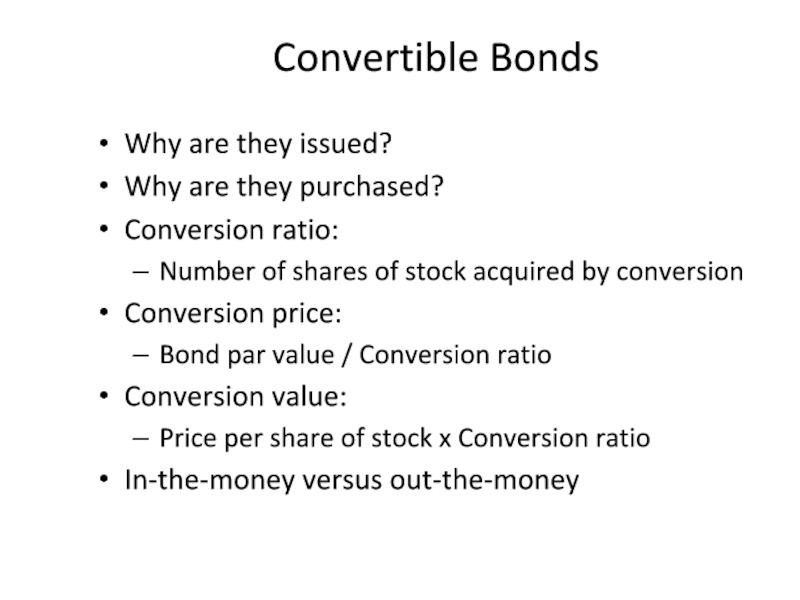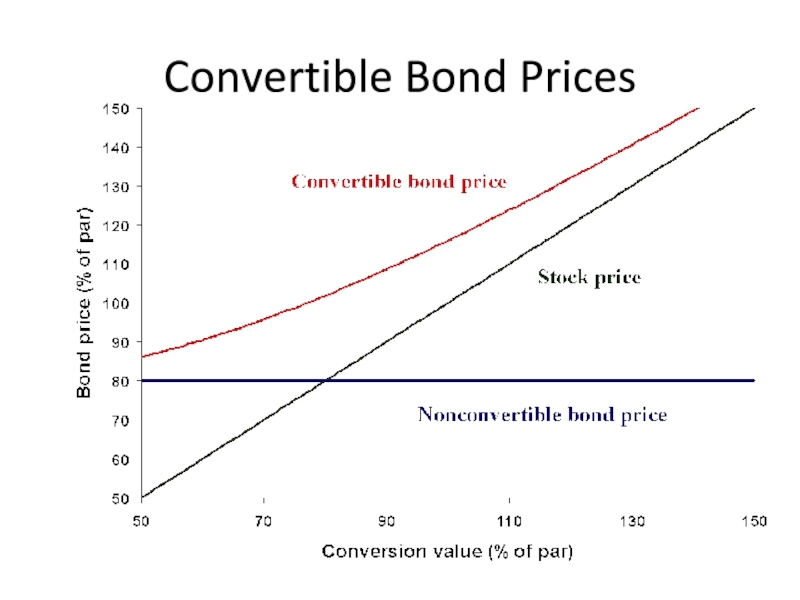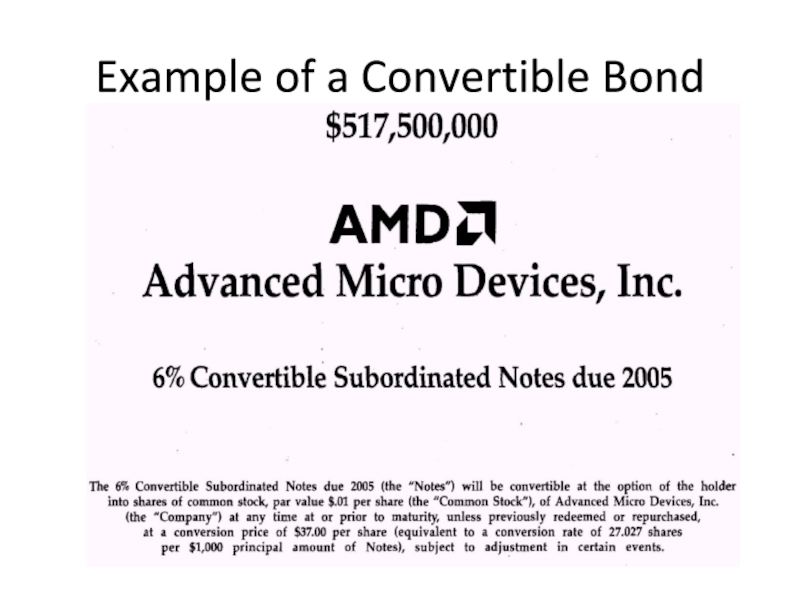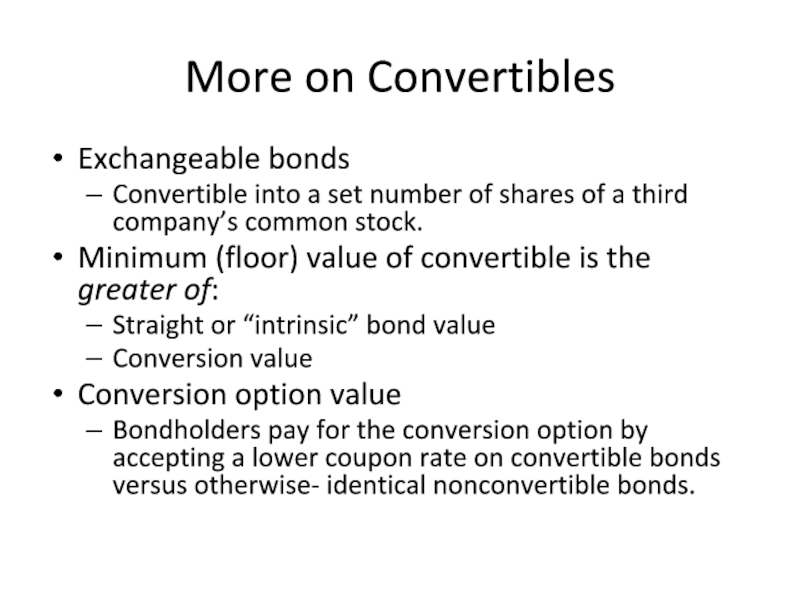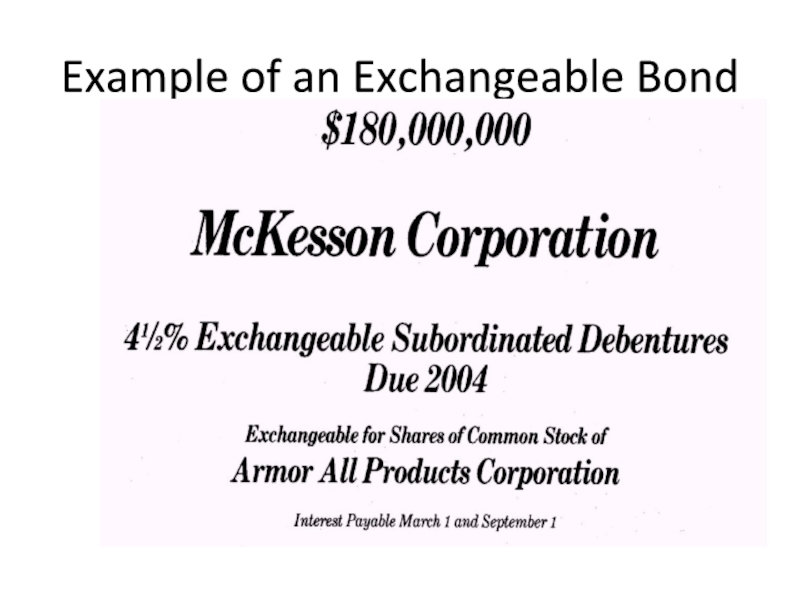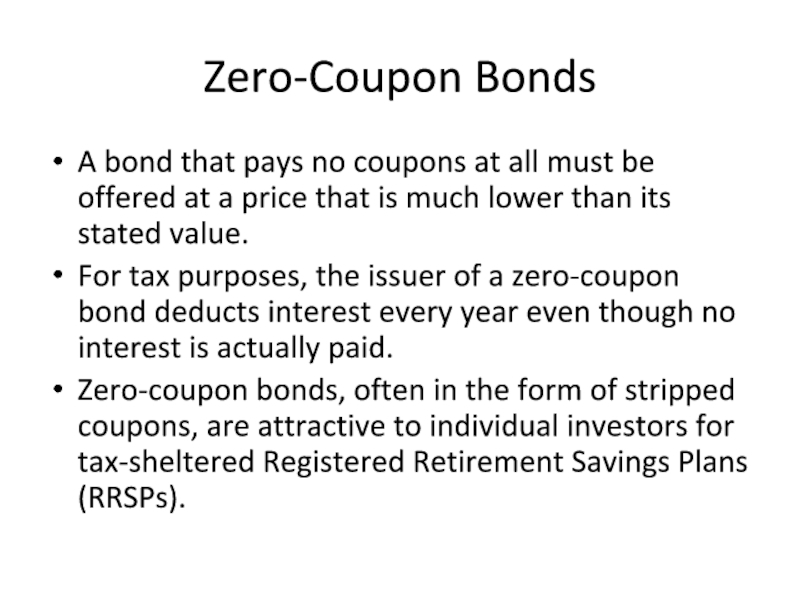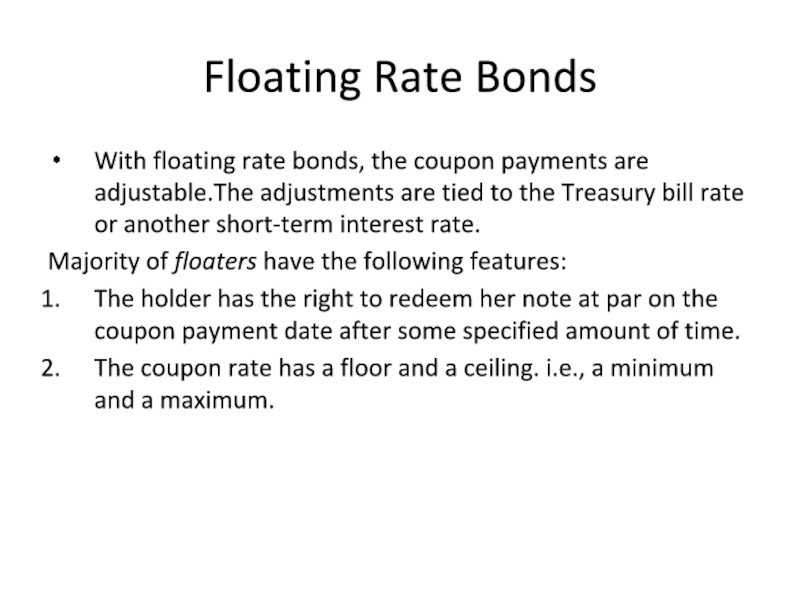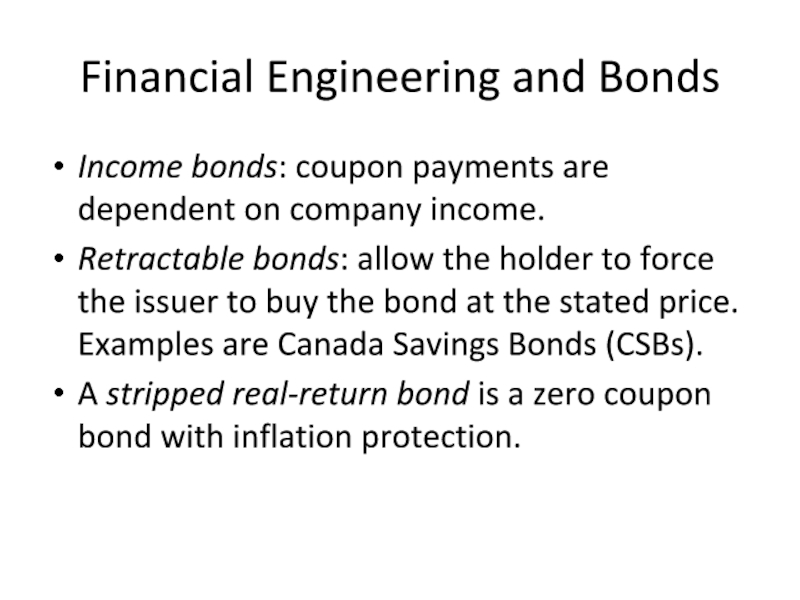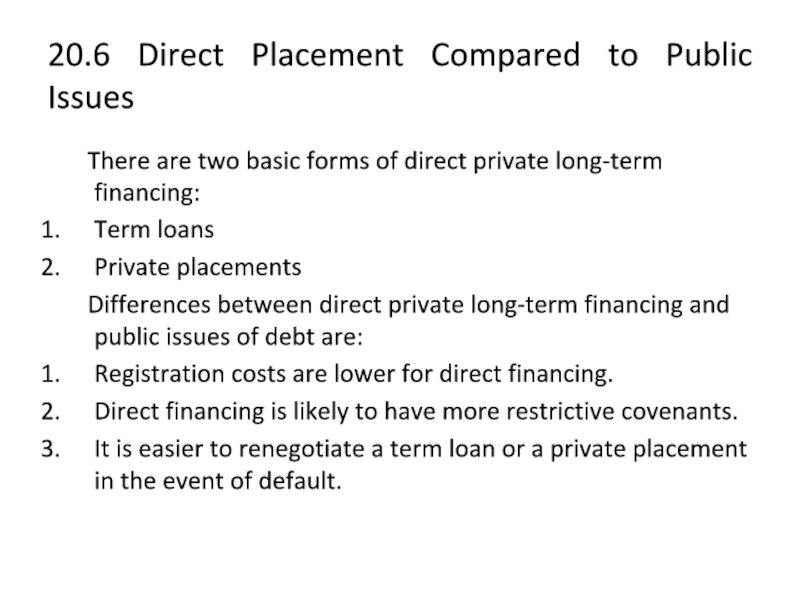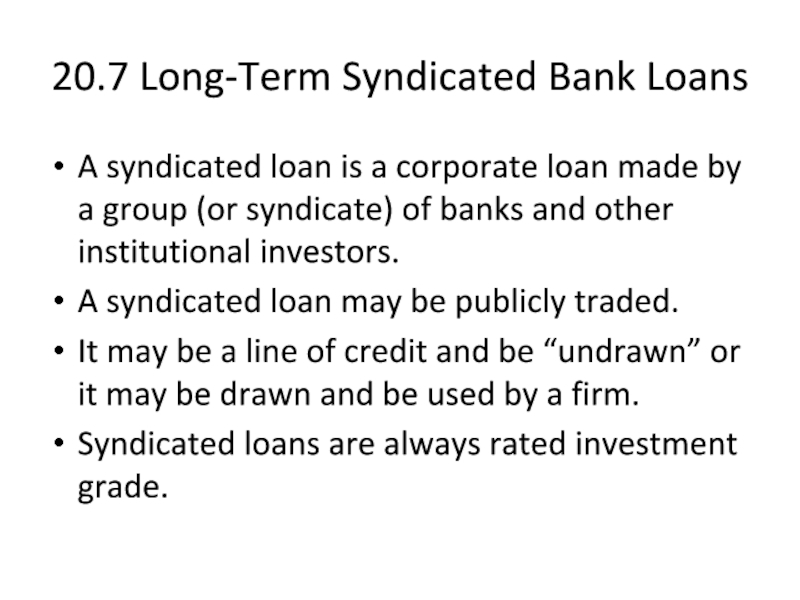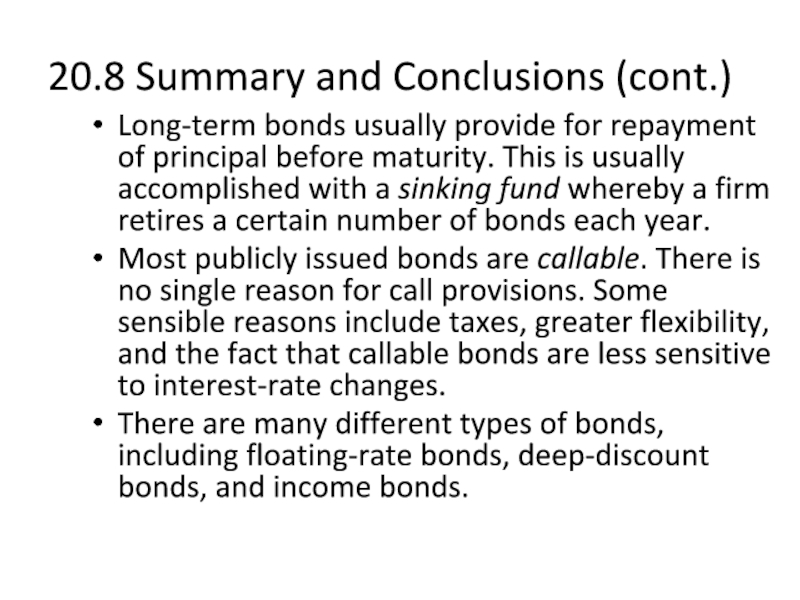Issue of Bonds
20.3 Bond Refunding
20.4 Bond Ratings
20.5 Some Different Types of Bonds
20.6 Direct Placement Compared to Public Issues
20.7 Long-Term Syndicated Bank Loans
20.8 Summary and Conclusions
- Главная
- Разное
- Дизайн
- Бизнес и предпринимательство
- Аналитика
- Образование
- Развлечения
- Красота и здоровье
- Финансы
- Государство
- Путешествия
- Спорт
- Недвижимость
- Армия
- Графика
- Культурология
- Еда и кулинария
- Лингвистика
- Английский язык
- Астрономия
- Алгебра
- Биология
- География
- Детские презентации
- Информатика
- История
- Литература
- Маркетинг
- Математика
- Медицина
- Менеджмент
- Музыка
- МХК
- Немецкий язык
- ОБЖ
- Обществознание
- Окружающий мир
- Педагогика
- Русский язык
- Технология
- Физика
- Философия
- Химия
- Шаблоны, картинки для презентаций
- Экология
- Экономика
- Юриспруденция
Long-Term Debt презентация
Содержание
- 2. Chapter 20 Long-Term Debt 20.1 Long Term
- 3. 20.1 Long Term Debt: A Review Corporate
- 4. Features of a Typical Bond The indenture
- 5. Features of a Hypothetical Bond
- 6. 20.2 The Public Issue of Bonds The
- 7. Principal Repayment Term bonds versus serial bonds
- 8. Protective Covenants Agreements to protect bondholders Negative
- 9. The Sinking Fund There are many different
- 10. The Call Provision A call provision lets
- 11. 20.3 Bond Refunding Replacing all or part
- 12. Should firms issue callable bonds? Common sense
- 13. Why are callable bonds issued in the
- 14. Callable Bonds versus Noncallable Bonds Most bonds
- 15. Calling Bonds: When does it make sense?
- 16. 20.4 Bond Ratings What is rated: The
- 17. Bond Ratings: Investment Grade
- 18. Bond Ratings: Below Investment Grade
- 19. Junk bonds Anything less than an S&P
- 20. 20.5 Different Types of Bonds Callable Bonds
- 21. Puttable bonds Put provisions Put price Put
- 22. Convertible Bonds Why are they issued? Why
- 23. Convertible Bond Prices
- 24. Example of a Convertible Bond
- 25. More on Convertibles Exchangeable bonds Convertible into
- 26. Example of an Exchangeable Bond
- 27. Zero-Coupon Bonds A bond that pays no
- 28. Floating Rate Bonds With floating rate bonds,
- 29. Financial Engineering and Bonds Income bonds: coupon
- 30. 20.6 Direct Placement Compared to Public Issues
- 31. 20.7 Long-Term Syndicated Bank Loans A syndicated
- 32. 20.8 Summary and Conclusions The details of
- 33. 20.8 Summary and Conclusions (cont.) Long-term bonds
Слайд 320.1 Long Term Debt: A Review
Corporate debt can be short-term (maturity
less than one year) or long-term.
Different from common stock:
Creditor’s claim on corporation is specified
Promised cash flows
Most are callable
Over half of outstanding bonds are owned by life insurance companies & pension funds
Plain vanilla bonds to “kitchen sink” bonds
Different from common stock:
Creditor’s claim on corporation is specified
Promised cash flows
Most are callable
Over half of outstanding bonds are owned by life insurance companies & pension funds
Plain vanilla bonds to “kitchen sink” bonds
Слайд 4Features of a Typical Bond
The indenture usually lists
Amount of Issue, Date
of Issue, Maturity
Denomination (Par value)
Annual Coupon, Dates of Coupon Payments
Security
Sinking Funds
Call Provisions
Covenants
Features that may change over time
Rating
Yield-to-Maturity
Market price
Denomination (Par value)
Annual Coupon, Dates of Coupon Payments
Security
Sinking Funds
Call Provisions
Covenants
Features that may change over time
Rating
Yield-to-Maturity
Market price
Слайд 620.2 The Public Issue of Bonds
The general procedure is similar to
the issuance of stock, as described in the previous chapter.
Indentures and covenants are not relevant to stock issuance.
The indenture is a written agreement between the borrower and a trust company. The indenture usually lists
Amount of Issue, Date of Issue, Maturity
Denomination (Par value)
Annual Coupon, Dates of Coupon Payments
Security
Sinking Funds
Call Provisions
Covenants
Indentures and covenants are not relevant to stock issuance.
The indenture is a written agreement between the borrower and a trust company. The indenture usually lists
Amount of Issue, Date of Issue, Maturity
Denomination (Par value)
Annual Coupon, Dates of Coupon Payments
Security
Sinking Funds
Call Provisions
Covenants
Слайд 7Principal Repayment
Term bonds versus serial bonds
Sinking funds: How do they work?
Fractional
repayment each year
Good news---security
Bad news---unfavourable calls
How trustee redeems
Good news---security
Bad news---unfavourable calls
How trustee redeems
Слайд 8Protective Covenants
Agreements to protect bondholders
Negative covenant: Thou shalt not:
pay dividends beyond
specified amount
sell more senior debt and amount of new debt is limited
refund existing bond issue with new bonds paying lower interest rate
buy another company’s bonds
Positive covenant: Thou shalt:
use proceeds from sale of assets for other assets
allow redemption in event of merger or spinoff
maintain good condition of assets
provide audited financial information
sell more senior debt and amount of new debt is limited
refund existing bond issue with new bonds paying lower interest rate
buy another company’s bonds
Positive covenant: Thou shalt:
use proceeds from sale of assets for other assets
allow redemption in event of merger or spinoff
maintain good condition of assets
provide audited financial information
Слайд 9The Sinking Fund
There are many different kinds of sinking-fund arrangements:
Most start
between 5 and 10 years after initial issuance.
Some establish equal payments over the life of the bond.
Most high-quality bond issues establish payments to the sinking fund that are not sufficient to redeem the entire issue.
Sinking funds provide extra protection to bondholders.
Sinking funds provide the firm with an option.
Some establish equal payments over the life of the bond.
Most high-quality bond issues establish payments to the sinking fund that are not sufficient to redeem the entire issue.
Sinking funds provide extra protection to bondholders.
Sinking funds provide the firm with an option.
Слайд 10The Call Provision
A call provision lets the company repurchase or call
the entire bond issue at a predetermined price overa specified period.
The difference between the call price and the face value is the call premium.
Many long-term corporate bonds outstanding in Canada have call provisions.
New corporate debt features a different call provision referred to as a Canada plus call.
The Canada plus call is designed to replace the traditional call feature by making it unattractive for the issuer ever to call the bonds.
The difference between the call price and the face value is the call premium.
Many long-term corporate bonds outstanding in Canada have call provisions.
New corporate debt features a different call provision referred to as a Canada plus call.
The Canada plus call is designed to replace the traditional call feature by making it unattractive for the issuer ever to call the bonds.
Слайд 1120.3 Bond Refunding
Replacing all or part of a bond issue is
called refunding.
Bond refunding raises two questions:
Should firms issue callable bonds?
Given that callable bonds have been issued, when should the bonds be called?
Bond refunding raises two questions:
Should firms issue callable bonds?
Given that callable bonds have been issued, when should the bonds be called?
Слайд 12Should firms issue callable bonds?
Common sense tells us that call provisions
have value.
A call works to the advantage of the issuer.
If interest rates fall and bond prices go up, the option to buy back the bonds at the call price is valuable.
In bond refunding, firms will typically replace the called bonds with a new bond issue.
The new bonds will have a lower coupon rate than the called bonds.
A call works to the advantage of the issuer.
If interest rates fall and bond prices go up, the option to buy back the bonds at the call price is valuable.
In bond refunding, firms will typically replace the called bonds with a new bond issue.
The new bonds will have a lower coupon rate than the called bonds.
Слайд 13Why are callable bonds issued in the real world?
Four specific reasons
why a company might use a call provision:
Superior interest rate predictions
Taxes
Financial flexibility for future investment opportunities
Less interest-rate risk
Superior interest rate predictions
Taxes
Financial flexibility for future investment opportunities
Less interest-rate risk
Слайд 14Callable Bonds versus Noncallable Bonds
Most bonds are callable; some sensible reasons
for call provisions include: taxes, managerial flexibility, and the fact that callable bonds have less interest rate risk.
Слайд 15Calling Bonds: When does it make sense?
In a world with no
transaction costs, it can be shown that the company should call its bonds whenever the callable bond value exceeds the call price.
This policy minimizes the value of the callable bonds.
The costs from issuing new bonds change the refunding rule to allow bonds to trade at prices above the call price.
The objective of the company is to minimize the sum of the value of the callable bonds plus new issue costs.
This policy minimizes the value of the callable bonds.
The costs from issuing new bonds change the refunding rule to allow bonds to trade at prices above the call price.
The objective of the company is to minimize the sum of the value of the callable bonds plus new issue costs.
Слайд 1620.4 Bond Ratings
What is rated:
The likelihood that the firm will default.
The
protection afforded by the loan contract in the event of default.
Who pays for ratings:
Firms pay to have their bonds rated.
The ratings are constructed from the financial statements supplied by the firm.
Ratings can change.
Raters can disagree.
Who pays for ratings:
Firms pay to have their bonds rated.
The ratings are constructed from the financial statements supplied by the firm.
Ratings can change.
Raters can disagree.
Слайд 19Junk bonds
Anything less than an S&P “BB” or a Moody’s “Ba”
is a junk bond.
A polite euphemism for junk is high-yield bond.
There are two types of junk bonds:
Original issue junk—possibly not rated
Fallen angels—rated
Current status of junk bond market
Private placement
Yield premiums versus default risk
A polite euphemism for junk is high-yield bond.
There are two types of junk bonds:
Original issue junk—possibly not rated
Fallen angels—rated
Current status of junk bond market
Private placement
Yield premiums versus default risk
Слайд 2020.5 Different Types of Bonds
Callable Bonds
Puttable Bonds
Convertible Bonds
Zero Coupon Bonds
Floating-Rate Bonds
Other
Types of Bonds
Слайд 21Puttable bonds
Put provisions
Put price
Put date
Put deferment
Extendible bonds
Value of the put feature
Cost
of the put feature
Слайд 22Convertible Bonds
Why are they issued?
Why are they purchased?
Conversion ratio:
Number of shares
of stock acquired by conversion
Conversion price:
Bond par value / Conversion ratio
Conversion value:
Price per share of stock x Conversion ratio
In-the-money versus out-the-money
Conversion price:
Bond par value / Conversion ratio
Conversion value:
Price per share of stock x Conversion ratio
In-the-money versus out-the-money
Слайд 25More on Convertibles
Exchangeable bonds
Convertible into a set number of shares of
a third company’s common stock.
Minimum (floor) value of convertible is the greater of:
Straight or “intrinsic” bond value
Conversion value
Conversion option value
Bondholders pay for the conversion option by accepting a lower coupon rate on convertible bonds versus otherwise- identical nonconvertible bonds.
Minimum (floor) value of convertible is the greater of:
Straight or “intrinsic” bond value
Conversion value
Conversion option value
Bondholders pay for the conversion option by accepting a lower coupon rate on convertible bonds versus otherwise- identical nonconvertible bonds.
Слайд 27Zero-Coupon Bonds
A bond that pays no coupons at all must be
offered at a price that is much lower than its stated value.
For tax purposes, the issuer of a zero-coupon bond deducts interest every year even though no interest is actually paid.
Zero-coupon bonds, often in the form of stripped coupons, are attractive to individual investors for tax-sheltered Registered Retirement Savings Plans (RRSPs).
For tax purposes, the issuer of a zero-coupon bond deducts interest every year even though no interest is actually paid.
Zero-coupon bonds, often in the form of stripped coupons, are attractive to individual investors for tax-sheltered Registered Retirement Savings Plans (RRSPs).
Слайд 28Floating Rate Bonds
With floating rate bonds, the coupon payments are adjustable.The
adjustments are tied to the Treasury bill rate or another short-term interest rate.
Majority of floaters have the following features:
The holder has the right to redeem her note at par on the coupon payment date after some specified amount of time.
The coupon rate has a floor and a ceiling. i.e., a minimum and a maximum.
Majority of floaters have the following features:
The holder has the right to redeem her note at par on the coupon payment date after some specified amount of time.
The coupon rate has a floor and a ceiling. i.e., a minimum and a maximum.
Слайд 29Financial Engineering and Bonds
Income bonds: coupon payments are dependent on company
income.
Retractable bonds: allow the holder to force the issuer to buy the bond at the stated price. Examples are Canada Savings Bonds (CSBs).
A stripped real-return bond is a zero coupon bond with inflation protection.
Retractable bonds: allow the holder to force the issuer to buy the bond at the stated price. Examples are Canada Savings Bonds (CSBs).
A stripped real-return bond is a zero coupon bond with inflation protection.
Слайд 3020.6 Direct Placement Compared to Public Issues
There are two basic forms
of direct private long-term financing:
Term loans
Private placements
Differences between direct private long-term financing and public issues of debt are:
Registration costs are lower for direct financing.
Direct financing is likely to have more restrictive covenants.
It is easier to renegotiate a term loan or a private placement in the event of default.
Term loans
Private placements
Differences between direct private long-term financing and public issues of debt are:
Registration costs are lower for direct financing.
Direct financing is likely to have more restrictive covenants.
It is easier to renegotiate a term loan or a private placement in the event of default.
Слайд 3120.7 Long-Term Syndicated Bank Loans
A syndicated loan is a corporate loan
made by a group (or syndicate) of banks and other institutional investors.
A syndicated loan may be publicly traded.
It may be a line of credit and be “undrawn” or it may be drawn and be used by a firm.
Syndicated loans are always rated investment grade.
A syndicated loan may be publicly traded.
It may be a line of credit and be “undrawn” or it may be drawn and be used by a firm.
Syndicated loans are always rated investment grade.
Слайд 3220.8 Summary and Conclusions
The details of the long-term debt contract are
contained in the indenture. The main provisions are: security, repayment, protective covenants, and call provisions.
Protective covenants are designed to protect bondholders from management decisions that favour stockholders at bondholders’ expense.
Most public industrial bonds are unsecured—they are general claims on the company’s value.
Most utility bonds are secured. If the firm defaults on secured bonds, the trustee can repossess the asset.
Protective covenants are designed to protect bondholders from management decisions that favour stockholders at bondholders’ expense.
Most public industrial bonds are unsecured—they are general claims on the company’s value.
Most utility bonds are secured. If the firm defaults on secured bonds, the trustee can repossess the asset.
Слайд 3320.8 Summary and Conclusions (cont.)
Long-term bonds usually provide for repayment of
principal before maturity. This is usually accomplished with a sinking fund whereby a firm retires a certain number of bonds each year.
Most publicly issued bonds are callable. There is no single reason for call provisions. Some sensible reasons include taxes, greater flexibility, and the fact that callable bonds are less sensitive to interest-rate changes.
There are many different types of bonds, including floating-rate bonds, deep-discount bonds, and income bonds.
Most publicly issued bonds are callable. There is no single reason for call provisions. Some sensible reasons include taxes, greater flexibility, and the fact that callable bonds are less sensitive to interest-rate changes.
There are many different types of bonds, including floating-rate bonds, deep-discount bonds, and income bonds.
